Drivers killed five pedestrians in September 2023 in Connecticut. That’s 39 preventable deaths of pedestrians and cyclists, so far, this year. I’m writing this in the 39th week of the year; the math is too easy.
At 1:10 AM on September 21, a ten-minute walk from New Britain’s City Hall, a police officer drove straight ahead into 40-year old Katherine Colon who was using Route 555 (West Main Street) at or by Lexington – reports about where she was are inconsistent, and frankly, distract from a few key facts that do not change this:
1. Not every intersection along West Main Street has a painted crosswalk, even though this is a densely populated area, and where Katherine was hit is at the end of the block from where one of the city’s major attractions lives: the New Britain Museum of American Art.
2. The officer was driving an SUV. New Britain is an urban area, yet police are issued vehicles better suited for rural environments where off-roading or traveling on unpaved roads would ever happen. Although SUVs have become a symbol of wealth and upward mobility, they are more dangerous than sedans, both to the environment (that’s also taxpayers’ money coming out the tailpipe) and humans. When larger vehicles like SUVs collide with humans walking, the injuries tend to be chest and head. These are less survivable. This is the second time in Connecticut this year that an officer killed a pedestrian with their police-issued SUV.
3. News photos showed the SUV had a visibly dented hood. This suggests driver was traveling at a high rate of speed – one unsafe for road conditions, with conditions being that this is a densely populated area where people should be expected day or night.
Two of those three points need to be addressed by examining police protocols and culture. Assigning SUVs to police in urban and most suburban settings is a form of negligence, as officers responding to calls are going to be traveling fast. High speeds and large vehicles are unforgiving. There is the question of when it is appropriate for someone to travel at higher speeds when responding to a call. If the call is not one where a person is currently at risk – and in this case, it is unclear if the burglary call was one where an intruder was inside a home or if this had been discovered later – you have to ask if it makes sense to put others’ lives in danger while responding. I will come out and say it: I do not want to die because someone’s television was stolen and a cop was racing over. Their tv is replaceable; I am not.
Currently, there is the question of whether or not the officer was running lights and sirens. That matters, but not to the extent that we focus on that aspect of individual choice and not one larger police culture issues. As with the deadly crash in Stamford back in July when an officer killed an elderly man who was checking his mailbox, there was an excessively-sized vehicle and the use of speed. We can ask why sirens and flashing lights are not automatically activated when the driver exceeds the posted speed limit.
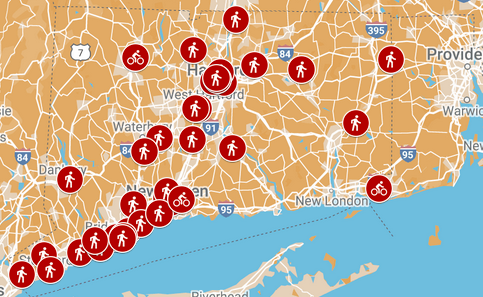
The first preventable death of September, though, happened one week into the month in Vernon, on Route 83 at Pitkin Road. This is in the Vernon Circle area – suburban sprawling stroad at its worst. Trina Gould, 43, was using the road around 5:15 AM when the driver of a 2005 Mini Cooper struck and killed her.
There are many restaurants and businesses on this state route — and in particular this area near several major plazas including Tri-City Plaza. Yet, the road design ignores the needs of pedestrians. Several legs of this intersection do not have a marked crosswalk or pedestrian signal. There is sidewalk along Route 83, but it seems people are expected to not really use it since they are not given a light or crosswalk markings on one side. Route 83 is five lanes at this point.
Two pedestrians have been injured previously at this intersection since 2015. In 2020, about 0.8 miles away on Route 83 at Hockanum Boulevard, a driver killed a pedestrian who was using a similar street design: missing marked crosswalk and pedestrian lights, sidewalk missing on an intersecting street, and where there are businesses that people would want to walk to.
I have seen nothing from Vernon’s VIPs about how they plan to improve Route 83 so that it is safer for all road users. There certainly have been no apologies for the policy failures that created this car-centric sprawl in the first place.
Ten days after a driver killed Trina Gould, a truck driver struck and killed a currently unidentified man around 8:45 PM on I-95 South in Stamford. The person was reportedly trying to cross from the south to north side of the Interstate. A different news source says that this happened at 12:45 AM and the person was struck in the northbound right lane. A third news source said he was crossing from the northbound to southbound side of the highway. And yet a fourth source said this happened at 8:45 PM and in the northbound section of highway. There are many unknowns here, and nothing has been said about if the pedestrian was on the highway due to having a disabled vehicle, or for some other reason. We will likely never hear about what happened because fatal crashes are constant, and the media is fickle and tends to follow whatever will boost ratings.
On September 21, two pedestrians were killed by drivers. The first was the aforementioned collision on West Main Street in New Britain. Then, at 9:47 AM on what was a clear, dry day, a driver struck Ramijlal Shrivastava, 70, who was using the intersection of Route 10/202 and Iron Horse Boulevard/Owens Brook Boulevard in Simsbury.
Despite proximity to the Farmington Canal Heritage Trail, a popular bike path, this intersection shows that Simsbury has not fully accepted the Complete Streets philosophy, seemingly treating biking and walking as purely recreational endeavors; safety is only protected when on segregated paths. Last year, in Simsbury, they had cyclists and pedestrians fighting over scraps.
In 2018, an 80-yr. old cyclist was injured at this intersection when she was traveling straight and a driver failed to yield, making a left turn and striking her. A bike-friendly community is not one where this happens.
On September 22, a third pedestrian was killed within 48 hours in Connecticut – this one in the Jewett City section of Griswold.
A driver struck and killed a 50-year old pedestrian Kandi Fortuna at the intersection of Connecticut Route 12 and Green Avenue around 8 PM.
The intersection appears to have a sprawling parking lot on one corner, and instead of separating the lot from the road with curb and sidewalk, the entire area functions as a driveway, which is dangerous for all road users. There are no marked crosswalks even though there is this parking lot and places nearby for people to cross the road for, from restaurants to homes. There is a nearby gas station. This is just before a school zone. The marked speed limit is 25 MPH.
While pedestrian infrastructure is like at C-/D+ where this person was killed, just a bit up the road a bit, where there are multiple churches, there is more effort to keep people alive. There you can find marked crosswalks including use of shark’s teeth and hi-vis pedestrian crossing signs. Just like in New Britain, Griswold could (sort of) figure it out in a few places, but chose not to maintain pedestrian safety everywhere that one would expect people moving around outside of cars.
From a media crime scene pic, you can see vehicle debris all over the Griswold road, indicating that the motorist chose to drive excessively fast through this area. They did not remain on the scene to render aid or take responsibility. From a GoFundMe, it’s mentioned that the motorist was intoxicated/impaired – once again raising the question why we do not require ignition interlocks as a standard feature of every single motor vehicle. It seems that Jewett City is served by exactly one bus route — SEAT route 8. It is meandering and runs hourly. This makes for poor alternative options to driving for those who are impaired.
So, five preventable pedestrian deaths in thirty days. This does not count those who’ve experience life-changing injuries, serious injuries, traumatizing close calls. It does not give the total number of people impacted by any of these losses.
I’ve been tracking these preventable deaths since January 2020, and there is a cycle of predictable responses that I will hear or read. Some are from those who want these deaths to stop, too, but cling to the beliefs they were raised on, that we can eradicate this problem by taking personal responsibility. Some are from drivers who are terrified that they may have to act like driving a car is operating heavy machinery, and so they deflect, expecting the most vulnerable people using the roadway to absorb all responsibility. Then there are the politicians and engineers/designers/planners who rarely accept that they wield the power to change these outcomes, and would rather send thoughts and prayers or, when absolutely pressed, begin years of studies that will result in the most piddly of changes.
October is Pedestrian Safety Month, a time that many fellow mobility advocates despise because of the victim-blaming messaging that is common. It’s cheap. It’s a way for organizations to check off a “community engagement” or “education” box. This is when we are infantilized with messaging that reminds us to look both ways (people already do), wear bright colors (and to hell with work dress codes), and make eye contact with drivers (who are looking at their phones).
Maybe victim-blaming infographics look sexier and more shareable, but I’m interested in not having to talk about this for the next fifty years, so maybe we try another tack?
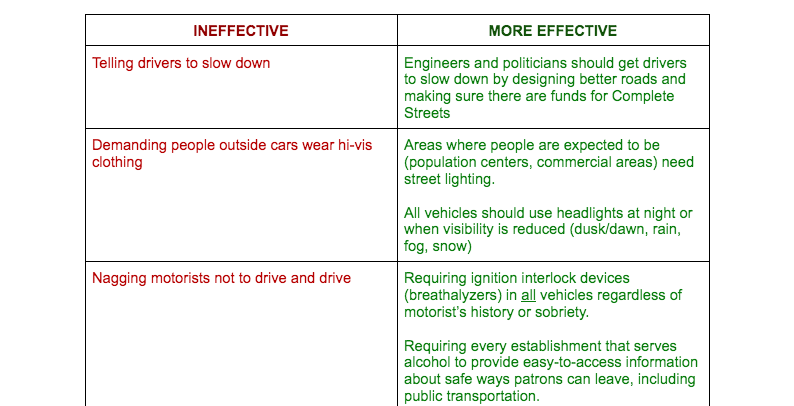
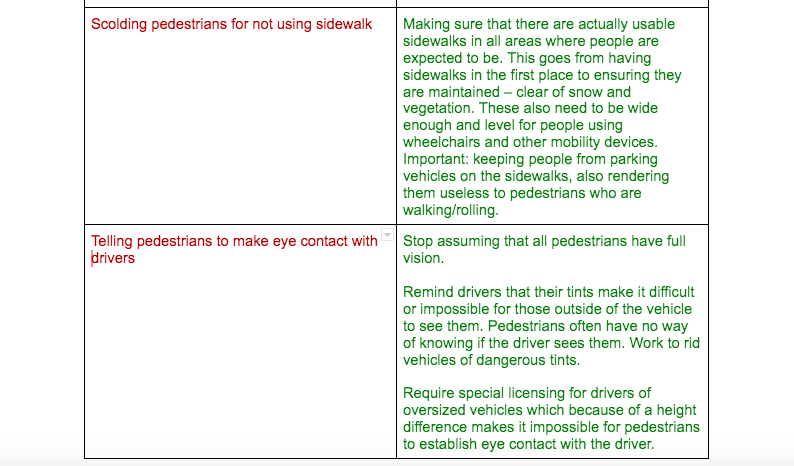
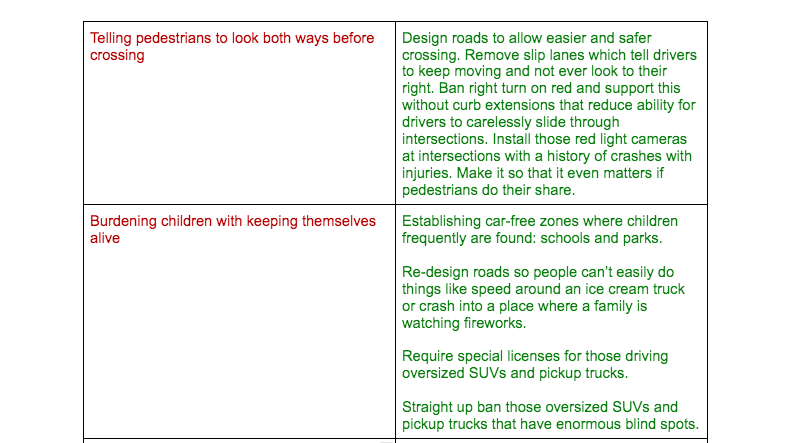
And finally!
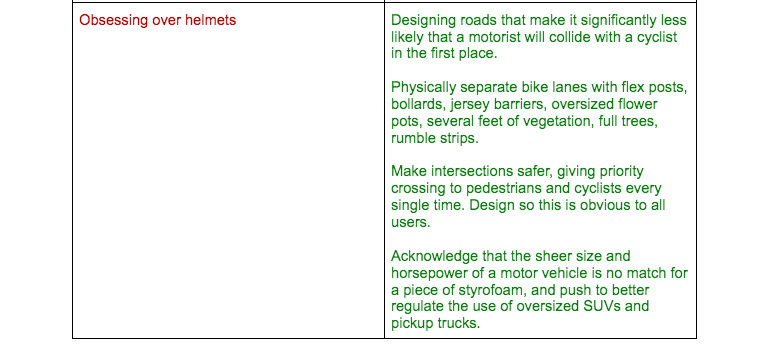
Instead of participating in the safety theater that gives a false sense of safety while also putting the burden of it on the road users most vulnerable to the greatest amount of harm, try any and all of those ideas in green. It takes more commitment to make asks that involve systems change, but these things actually make a difference.
In November, there will be a World Day of Remembrance Event in Hartford. This will commemorate the 600+ people who have died preventable deaths on Connecticut’s roads in 2022 and 2023. There will be a reading of the names of the pedestrians and cyclists who have been killed. Victims’ families will speak. If there were anything like justice, each and every person holding the power to design better roads or allow them through policy and funds, would have to stand in attendance and listen to the sound of loss. This event will be in Bushnell Park from 1-3 PM on November 19, 2023.
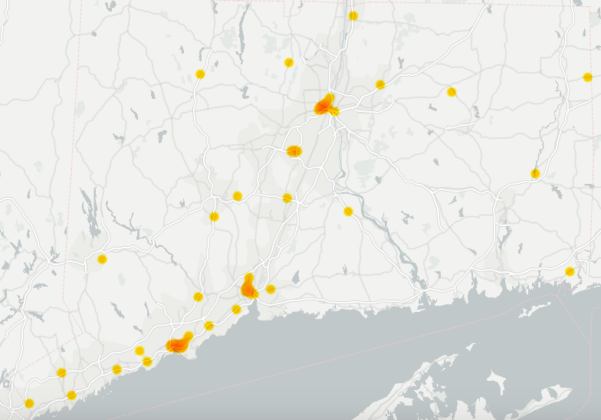
DMC
I lost my niece on 9/7 on Route 83, Vernon, CT. Still do not know the whole story as the investigation will take months but I do know Trina was not planning on dying that day.
Kerri Ana Provost
I am sorry for your loss!
On November 19, there will be a World Day of Remembrance event in Hartford’s Bushnell Park. I am not involved in the organizing of this event, but you can see more about it here:
https://watchformect.org/world-day-of-remembrance-nov-19-2023/